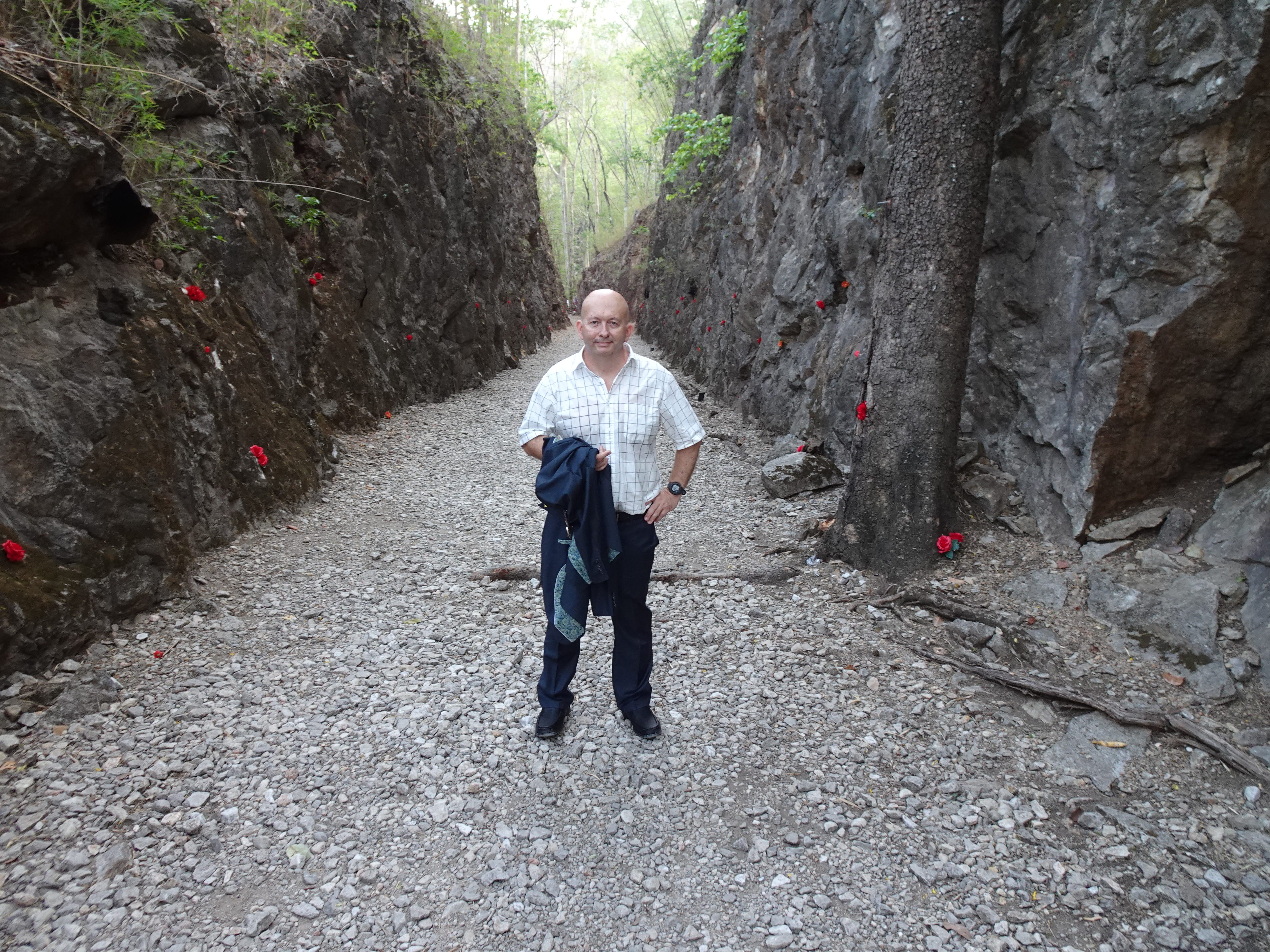Visiting Hellfire Pass for the Anzac Day Dawn Service
One of the most special Anzac Day services is held at Thailand’s Hellfire Pass each year, recognising the atrocities that Australian POWs suffered during the construction of the Burma-Thailand railway for the Japanese during World War II.

Hellfire Pass, also known as Konyu Cutting, is the location of the deepest and longest rock cutting along the entire length of the railway, and over the years came to symbolise the suffering and maltreatment of Australian prisoners of the Japanese across the Asia–Pacific region in WWI. The name ‘Hellfire Pass’ came from the appalling working conditions at and around the site.
In mid-1943, when the Japanese introduced a ‘Speedo’ to meet tight deadlines for completing the railway, prisoners were forced to work long hours into the night. Their work site was lit by oil lamps and bamboo fires. This flickering light, the noise from the drilling of the rock and the shuffling of hundreds of poorly fed prisoners seemed the very image of hell.

Construction of Hellfire Pass began in April 1943. Prisoners worked for up to 18 hours a day to complete the cutting using hand tools and sledge hammers to remove solid limestone and quartz rock.
The work consisted of two cuttings, the first 460m in length and 7.6m deep and the second, 73m by 24m.
Completed in August 1943, Hellfire Pass cost the lives of approximately 700 allied prisoners. More than 60,000 Australian, British, Dutch and American POWs worked on the Thai-Burma railway. An estimated 270,000 Asian civilians worked on the railway. More than 12,500 POWs died on the railway, including some 2,800 Australians. An estimated 75,000 South-East Asian civilian labourers also died.
Why build a railway?
The Burma-Thailand railway was built in 1942–1943 to supply Japanese forces to Burma, allowing the Japanese to bypass the sea routes that were made vulnerable when Japanese naval strength was reduced in the Battles of the Coral Sea and Midway in May and June 1942.
Once the railway was completed, the Japanese were planning to attack the British in India, and in particular the road and airfields used by the Allies to supply China over the Himalayan Mountains.

Construction of the Burma-Thailand railway began in October 1942 and was completed on 16 October 1943, the railway stretched 415 kilometres between Nong Pladuk in Thailand and Thanbyuzayat in Burma (now known as Myanmar).
Anzac Day Dawn Service
The annual Anzac Day Dawn Service is held at the rail cutting at Hellfire Pass at 5:30am. The location can be accessed via the carpark and stairs at the Hellfire Pass Interpretive Centre at the Sai Yok District of the Kanchanaburi province.
The facility is opened to the public at 3am on Anzac Day. It is free to attend. The area is well lit, including with oil lamps inside the rail cutting.

At the 2024 Dawn Service attendees were given a program guide, mini torch, commemorative sticker and a Hellfire Pass Interpretive Centre visitor guide booklet. There was no pre-registration required to attend the service, but seating in the temporary grandstand was allocated to those who arrived early at the site.
Several golf carts are available to transport people who require assistance to attend the site — people who visit Hellfire Pass generally access the area via stairs.

My wife, myself and friends arrived at Hellfire Pass at 4am, and found about 300 people already at the site. We were lucky to be assigned to the final seats in the grandstand. The organisers of the Anzac Day event, the Australian Embassy in Bangkok, advised attendees beforehand that if Hellfire Pass became crowded they could watch the service on a large screen upstairs at the Hellfire Pass Interpretive Centre.


After the service
The Anzac Day Dawn Service at Hellfire Pass is a 30 minute event that concludes at approximately 6am.
At the conclusion of the event, attendees are invited to lay their own wreaths and memorial items. Many attendees took photographs of the site, some exited by walking along the former rail corridor north to Hintok Cutting.
The Australian Embassy hosted a breakfast for Dawn Service attendees outside the Hellfire Pass Interpretive Centre.

An Anzac Day memorial serice was held at the Kanchanaburi War Cemetery at 11am, it was followed by a march that commenced at the nearby Death Railway Museum.

How to get to Hellfire Pass on Anzac Day
Hellfire Pass is best accessed by road. A lot of attendees stay at accommodation located in the town of Kanchanaburi, which is a 1 hour drive south of Hellfire Pass. Others stay at smaller accommodation facilities dotted around the Hellfire Pass region — but this accommodation needs to be pre-booked well in advance.

A regular rail service operates along the former Thai-Burma rail corridor between Bangkok and Kanchanaburi. Some people catch the train to Kanchanaburi where they stay at accommodation in the town, and then engage a driver’s services for the trip to Hellfire Pass for the Anzac Day Dawn Service. You’ll find more details about the rail trip to Kanchanaburi here.
For our trip, we hired a driver and his 8-seater van in Bangkok for several days — this took a lot of pressure off our travel itinerary. He coordinated his own accommodation for the trip, and we paid for the petrol bill at the end of the trip. This cost us only about AUS$130 a day, including petrol.
Death Railway places to visit in Kanchanaburi
In Kanchanaburi there are several places where you can visit World War II history.
River Khwae railway bridge
Tip: You can walk along the rail line on this bridge, and stand in a safety zone on the bridge as trains travel past.


Kanchanaburi War Cemetery
This is one of two prisoner of war cemeteries in the township of Kanchanaburi. There are 5,085 Commonwealth casualties of WWII buried or commemorated at the Kanchanaburi War Cemetery. There are also 1,896 Dutch war graves and 1 non-war grave.

Chungkai War Cemetery
This is one of two prisoner of war cemeteries in the township of Kanchanaburi. There are 1,426 Commonwealth and 313 Dutch burials at this WWII cemetery.
Death Railway Museum and Research Centre
The Death Railway Museum and Research Centre was founded by Queensland man Rod Beattie in 2003 and is the best museum for credible information about the construction of the Thailand-Burma Railway line.

The JEATH War Museum
The JEATH War Museum is located not far from River Kwai Bridge. This museum appears to have been created by locals from Kanchanaburi, with some help from the Japanese.
Chungkai Cutting
Chungkai Cutting was cut by British prisoners of war based in the nearby Chungkai camp, which later became a major POW hospital. The rail cutting is located near the W Story Cafe — walk down the stairs to the rail line to access the cutting.


Memories of the Burma-Thai Railway
This hard-to-find amateur museum that has dozens of large photographs taken along the Burma-Thai railway during its construction. Walk past the Buddha statue and the public bathrooms to find the bamboo hut that houses the museum.
Anzac Day Dawn Service Podcast
You’ll find highlights audio recorded at the 2024 ANZAC Day Dawn Service at Thailand’s Hellfire Pass on Spotify here.
In the ANZAC Day service you will hear Chaplain Santina Waugh, Australian Ambassador to Thailand Her Excellency Dr Angela Macdonald PSM, New Zealand Ambassador to Thailand His Excellency Jonathan Kings, the Statement of Remembrance read by Australia’s Chief of Joint Operations Lieutenant General Greg Bilton AO CSC, the Ode of Remembrance read by New Zealand Defence Attache to Thailand Colonel Peter Hall, the Last Post & Reveille by LSMUSN Dorian Broomhall, the British Club Bangkok Pipe Band, and Australian veterans Jamie Bullows and Graeme Crouch.

You’ll find more information about Kachanaburi and Hellfire Pass here and detailed information about the history of the Australian POWs on Death Railway here.
Lest We Forget


#AnzacDay #HellFirePass #Thailand
